Chayote
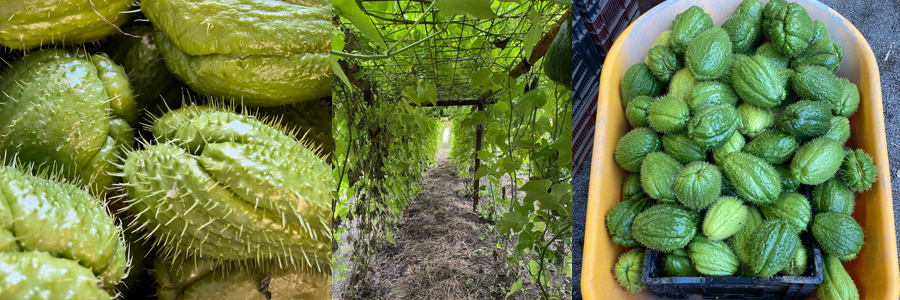
A few of you might find the fierce looking chayote that I’ve put in your harvest share box to be somewhat alarming. Fear not! Beneath it’s seemingly hostile exterior the chayote is actually a mild-mannered, healthy, economical and tasty friend in the kitchen with a worldwide fan-base. In case you don’t already know the chayote plant by reputation or from personal experience, let me make a formal introduction:
Every plant’s leaf is essentially a solar panel, erected and unfolded with the express purpose of gathering the sun’s energy in order to power the growth, maintenance, and eventual reproduction of the organism. The chayote’s broad, flat, and soft, pliable leaf is a clue that it might be a fast growing plant, and indeed it is. Not only do broad, flat leaves capture lots of sunshine and provide the power for rapid growth in high light environments, they’re also useful for plants that are growing in lower light situations to capture any and all of the available photons, and we see that the chayote employs both strategies for survival. Chayotes evolved in the area we now know as Central America, especially southern Mexico, Guatemala, and Honduras. The Chayote is a sprawling creature, spreading out over any available ground while sending long, tendriled vines high into and through the canopy of nearby trees, emerging from the tangled branches that make up the roof of the jungle into the bright light just that much closer to the sun.
If leaves are “solar panels,” then tubers are “batteries.” A chayote vine may trail 50 feet up a tree to chase the sun but it is sending the energy it gathers down the tangle of its stems into a tuber buried under the ground. The tuber stores the sun’s energy in the form of sugar and starch. A tuberous growth habit is a typical survival mechanism for tropical plants that can experience sudden, unexpected frosts that will burn up tender, exposed foliage. Yes, the Central American ecosystem where chayote evolved is usually warm, humid, and sunny, but mountains are mountains, and every once in a while there’s a sudden, hard frost that stings the higher elevations. The chayote that gets burned to the ground by the cold can always stage a comeback by sending up new shoots from the buried tuber that was insulated by the protective embrace of the earth. Potatoes do this too; they’re from the tropical Andes where the inconsistency of the weather is the only “constant.”
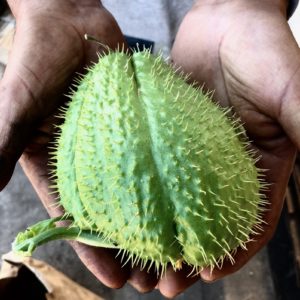
Oaxacan Chayote
A wild chayote’s fruit is spiny, which tells us that there’s something tasty there to be protected. The chayote is in the squash family, the Cucurbitaceae, and the flesh of its fruit is dense and mild flavored. A mouse or wild boar might want to eat the chayote but the gourd’s stiff spines are not very inviting. The indigenous people who lived across the natural range of the chayote learned to peel the spines off and enjoy the flesh of the fruit either raw, sliced thin and made tender with lime juice or salt, or steamed, boiled, baked or grilled.Like its cousin, the zucchini, the chayote has a mild flavor that can serve as a “delivery vehicle” for any number of more emphatic and unctuous sauces like mole. Our modern name for the crop, “Chayote,” comes from the Nahuatle word, “chayotli,” but as the crop gained popularity and spread south into what’s now South America it picked up other names, like “Chuchu,” or “Cahiote.” The fruits were harvested and used like squash, the tendrils and leaves were used as greens and added to soups and stews, and the tubers were dug up and cooked like potatoes.
When the Spanish voyagers came to the “New World” the chayotes jumped aboard their sailing boats. Despite its many uses, the chayote was not initially welcomed back in Europe. Like other indigenous American crops that feature in the “Columbian Exchange,” like the potatoes, tomatoes, and chili peppers, the chayote was suspect because it was not mentioned in the Bible. Since it didn’t get a specific name drop in Genesis, doesn’t that mean that the chayote might not have been created by God, but rather by Satan?
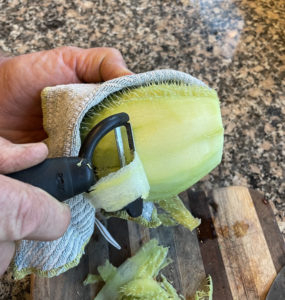 Once their colonies were established the Spaniards gathered up once a year, the immense piles of silver, gold, and jewels that they robbed from their new American subjects, or dug with slave labor from American mines and loaded up their ships with the booty, setting sail for Asian ports where they would trade. The treasure fleet that left from the port of San Blas, in Nyarit, was called the Manila Galleon, because its first port of call was in the Philippines. Filipino cooks were unconcerned with chayote’s suspected Satanic origins and they took to crop fast. Tagalog for chayote is “Sayote.” From Manila the culture and appreciation of the chayote spread out across Asia. You know that little chunk of something white and unknown that was covered in sauce in your Chinese takeout and you ate it without worrying? Chances are strong that was chayote.
Once their colonies were established the Spaniards gathered up once a year, the immense piles of silver, gold, and jewels that they robbed from their new American subjects, or dug with slave labor from American mines and loaded up their ships with the booty, setting sail for Asian ports where they would trade. The treasure fleet that left from the port of San Blas, in Nyarit, was called the Manila Galleon, because its first port of call was in the Philippines. Filipino cooks were unconcerned with chayote’s suspected Satanic origins and they took to crop fast. Tagalog for chayote is “Sayote.” From Manila the culture and appreciation of the chayote spread out across Asia. You know that little chunk of something white and unknown that was covered in sauce in your Chinese takeout and you ate it without worrying? Chances are strong that was chayote.
I’ve started growing chayote under the influence of my foreman, Fidel, and the Oaxacans I’ve been working with. It’s been a fun crop to learn about. The trick for success in growing any plant is to learn where and under what conditions it evolved, and to mimic that setting as much as possible. If a plant germinates and feels “at home,” the chances are very high that it will grow successfully. We bury each chayote that we intend to grow in a gopher basket so that the pesky rodents can’t harvest before we do. We erect a frame of 4×4 posts cloaked in chicken wire to give the vines something to climb on, like the thickets of sticks that natural chayotes would encounter in a natural setting, and then we give the plantation a thorough, gentle soak every once in a while, just like the rains they would experience in their Oaxacan or Honduran mountain homes. The chayote plants seem very happy here.
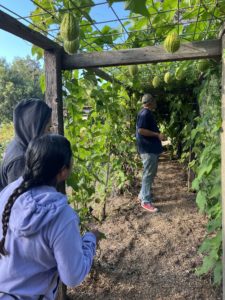 I had a couple of Oaxacan women visit the farm the other day and do a chayote “U-Pick.” They prefer the spiny chayotes, which is the variety that they know from back home. We have several different kinds of chayote growing, including the smooth forms that are preferred in Asian markets. What I’ve noticed is that the spiny chayotes come first, and the spineless, smooth chayotes tend to take a couple of weeks longer to develop, even though they were all planted at the same time. Maybe I’m just dull and insensitive, but the several kinds all taste pretty much the same.
I had a couple of Oaxacan women visit the farm the other day and do a chayote “U-Pick.” They prefer the spiny chayotes, which is the variety that they know from back home. We have several different kinds of chayote growing, including the smooth forms that are preferred in Asian markets. What I’ve noticed is that the spiny chayotes come first, and the spineless, smooth chayotes tend to take a couple of weeks longer to develop, even though they were all planted at the same time. Maybe I’m just dull and insensitive, but the several kinds all taste pretty much the same.
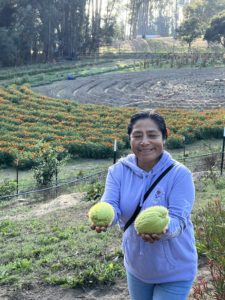 I hope you enjoy eating the chayote as much as I have enjoyed growing them. You can use them almost anyway you would any other summer squash. I’ve enjoyed them in saute and dressed with lemon or lime juice. You can keep them in the fridge, but you don’t need to. They’re perfectly able to hang out at room temperature on the counter and you can enjoy them as weird vegetal sculptures before you cook them.
I hope you enjoy eating the chayote as much as I have enjoyed growing them. You can use them almost anyway you would any other summer squash. I’ve enjoyed them in saute and dressed with lemon or lime juice. You can keep them in the fridge, but you don’t need to. They’re perfectly able to hang out at room temperature on the counter and you can enjoy them as weird vegetal sculptures before you cook them.
Andy and the Crew at Mariquita Farm
© 2022 Essay by Andy Griffin
Photos by Andy Griffin and Starling Linden


